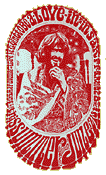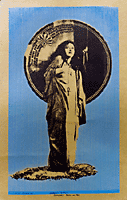
 |
||||||||||||||

|
||||||||||||||||
|
Had his designs been more widely dispersed, Robert "Bob" Wendell might today be recognized as one of the most talented poster artists of the psychedelic era. However, because he worked in sprawling Southern California, where the poster movement was not nearly as prominent an enterprise as it was in the more compact Bay Area, his output was not well distributed. Consequently, his innovative designs are rarely seen on the poster collector market. Nor has Wendell's work been reproduced in the recent books on the psychedelic poster phenomenon or included in the major exhibitions of psychedelic art that have traveled to museums across the United States. Robert Wendell grew up in Oregon and New Mexico, but has spent his entire artistic career in Southern California. From boyhood, he loved to draw, and received thorough training in that discipline at a number of art schools in New Mexico and California. He studied as a scholarship student at the Bistram School in Taos, New Mexico; at Los Angeles City College for two years; at Chouinard Art Institute (now California Art Institute in Valencia), where he studied with the great draftsman Rico LeBrun (1900-1964) and at the Otis Art Institute, where he earned an MFA to complete his schooling. Wendell is a talented graphic artist and illustrator. In the 1960s he developed packaging and marketing materials for a number of large corporations, including Quaker Oats, Scott Paper and Coca-Cola. He also worked extensively in television production, making more than one hundred TV commercials. Wendell first entered the poster arena in the early 1960s when he produced concert posters for the pop duo Jan and Dean. |
||||||||||||||||
 |
 |
|||||||||||||||
| Take
the Flyer on the LSD (1967) Robert Wendell Lithograph, 20" x 13" The Esoteric Poster Company |
||||||||||||||||
| Psychedelic
Madonna (1968) Robert Wendell Serigraph, 26" x 13" Esoteric/Gawd Awful |
||||||||||||||||
|
In 1966, Wendell became one of several artists who began working with Howard Morseburg. Morseburg had an art gallery in the old Westlake Park district of Los Angeles and had been publishing and distributing posters through his Esoteric Poster Company since the early part of the decade. 1966 was the dawn of the "Psychedelic Era," and, inspired by the counterculture, innovative artists in San Francisco had begun to design colorful "psychedelic" posters using attention-grabbing images with graphic letterforms curved around them. Because Wendell was a powerful draftsman with a background in graphic and printmaking, he adapted easily to the psychedelic style and soon created several poster designs. Wendell and Morseburg also updated the designs of a series of satirical drug posters the latter had published with Roland Crump back in 1961. The psychedelic images that Wendell designed for Esoteric Poster Company were printed as silkscreen prints. He added "Gawdawful Graphics," "Wendell Graphics" or "Blue Light Press" (or one of his other studio names) to each of the images that he printed. The silkscreen process, which uses a different screen for each individual color, is an artistic one, but the process is time-consuming and not suited to large-scale production. Wendell and Morseburg face other difficulties in making success out of their postre enterprise. While Morseburg had some success in producing and distributing his earlier posters through bookstores, he did not have the time or the familiarity with the counterculture to successfully market the psychedelic posters to the new youth market. The silkscreen prints also proved to be more expensive to produce, making them less competitiive in a market where the consumers had a very limited budget. By 1968, Wendell and Morseburg had parted company, and Esoteric's remaining inventory was stored away. In 1974 Wendell began teaching at Orange Coast College in Costa Mesa, California, where he has taught courses in life drawing, freehand drawing, graphic design, advertising design, watercolor painting and printmaking. Today, even though he is in his sixties, he remains an Associate Professor of Art and continues to teach drawing courses, as he still sees that activity as the necessary foundation for all artistic endeavors. Wendell has traveled extensively, living and working in Tahiti for a year and venturing to South America and Europe. In recent years he has designed a series of thirty-eight stained-glass windows for St. Peter's Caldean Church in San Diego and a large mural on the history of California for the Brea branch of Southern California Bank. He is currently working on a book on figure drawing which he hopes will be his legacy to art students. |
||||||||||||||||
| Jeffrey Morseburg | ||||||||||||||||
| Copyright
2003 Jeffrey Morseburg Not to be reproduced without the author's specific permission. |
||||||||||||||||